BMS512 Business Finance Report: Investment Appraisal and Analysis
VerifiedAdded on 2023/06/14
|15
|4026
|191
Report
AI Summary
This business report assesses investment proposals using payback period and net present value methods, ranking projects based on these metrics. It discusses mutually exclusive project selection, the strengths and weaknesses of each method, and qualitative factors influencing investment decisions. The report also explores funding options like bank finance, retained earnings, and debt financing, differentiating between financing and investment decisions. Furthermore, it includes a variance analysis for K Plc manufacturer and explains the variances identified. Finally, the report compares centralized and decentralized procurement, outlining the benefits of each approach. Desklib offers a wealth of similar solved assignments and past papers for students.

BUSINESS REPORT
Paraphrase This Document
Need a fresh take? Get an instant paraphrase of this document with our AI Paraphraser
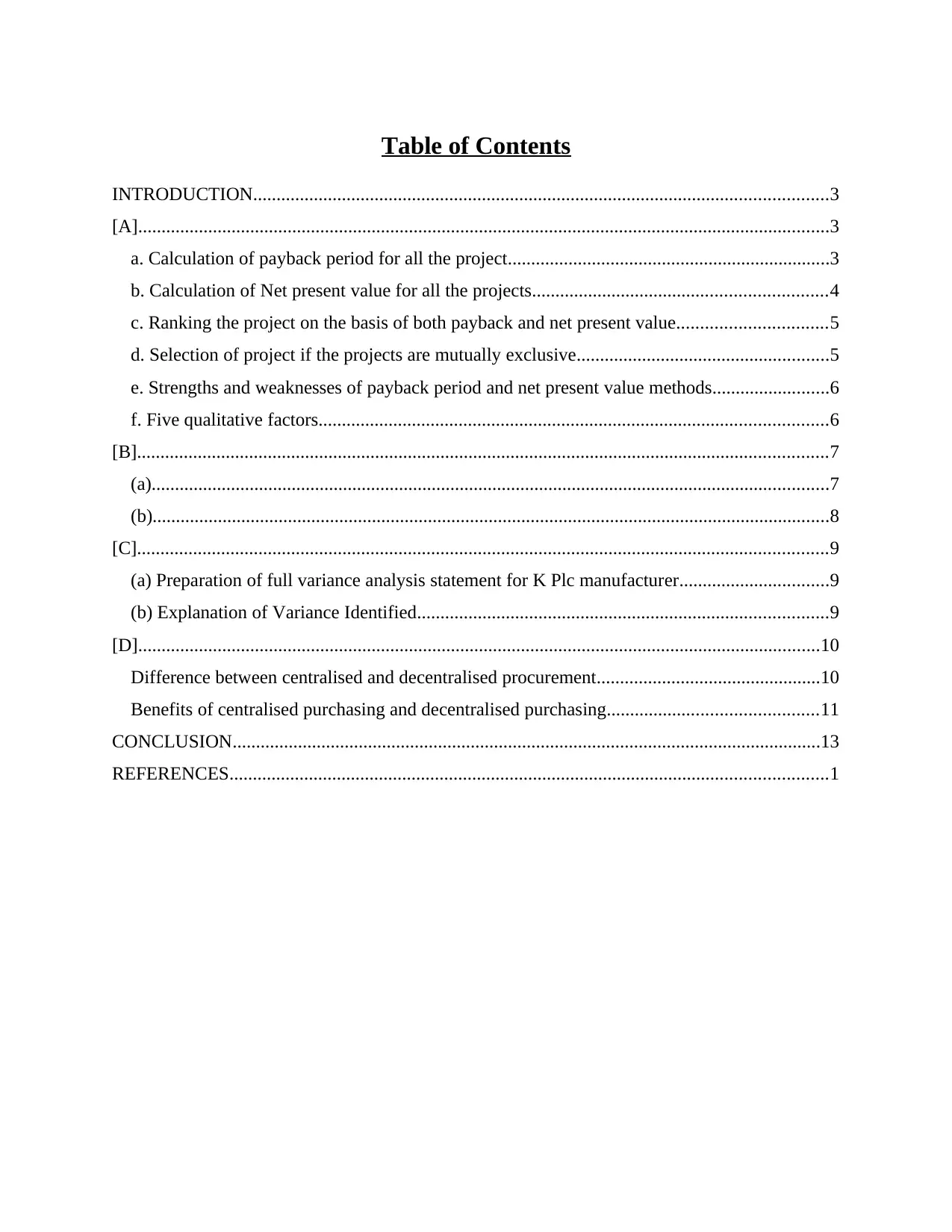
Table of Contents
INTRODUCTION...........................................................................................................................3
[A]....................................................................................................................................................3
a. Calculation of payback period for all the project.....................................................................3
b. Calculation of Net present value for all the projects...............................................................4
c. Ranking the project on the basis of both payback and net present value................................5
d. Selection of project if the projects are mutually exclusive......................................................5
e. Strengths and weaknesses of payback period and net present value methods.........................6
f. Five qualitative factors.............................................................................................................6
[B]....................................................................................................................................................7
(a).................................................................................................................................................7
(b).................................................................................................................................................8
[C]....................................................................................................................................................9
(a) Preparation of full variance analysis statement for K Plc manufacturer................................9
(b) Explanation of Variance Identified........................................................................................9
[D]..................................................................................................................................................10
Difference between centralised and decentralised procurement................................................10
Benefits of centralised purchasing and decentralised purchasing.............................................11
CONCLUSION..............................................................................................................................13
REFERENCES................................................................................................................................1
INTRODUCTION...........................................................................................................................3
[A]....................................................................................................................................................3
a. Calculation of payback period for all the project.....................................................................3
b. Calculation of Net present value for all the projects...............................................................4
c. Ranking the project on the basis of both payback and net present value................................5
d. Selection of project if the projects are mutually exclusive......................................................5
e. Strengths and weaknesses of payback period and net present value methods.........................6
f. Five qualitative factors.............................................................................................................6
[B]....................................................................................................................................................7
(a).................................................................................................................................................7
(b).................................................................................................................................................8
[C]....................................................................................................................................................9
(a) Preparation of full variance analysis statement for K Plc manufacturer................................9
(b) Explanation of Variance Identified........................................................................................9
[D]..................................................................................................................................................10
Difference between centralised and decentralised procurement................................................10
Benefits of centralised purchasing and decentralised purchasing.............................................11
CONCLUSION..............................................................................................................................13
REFERENCES................................................................................................................................1
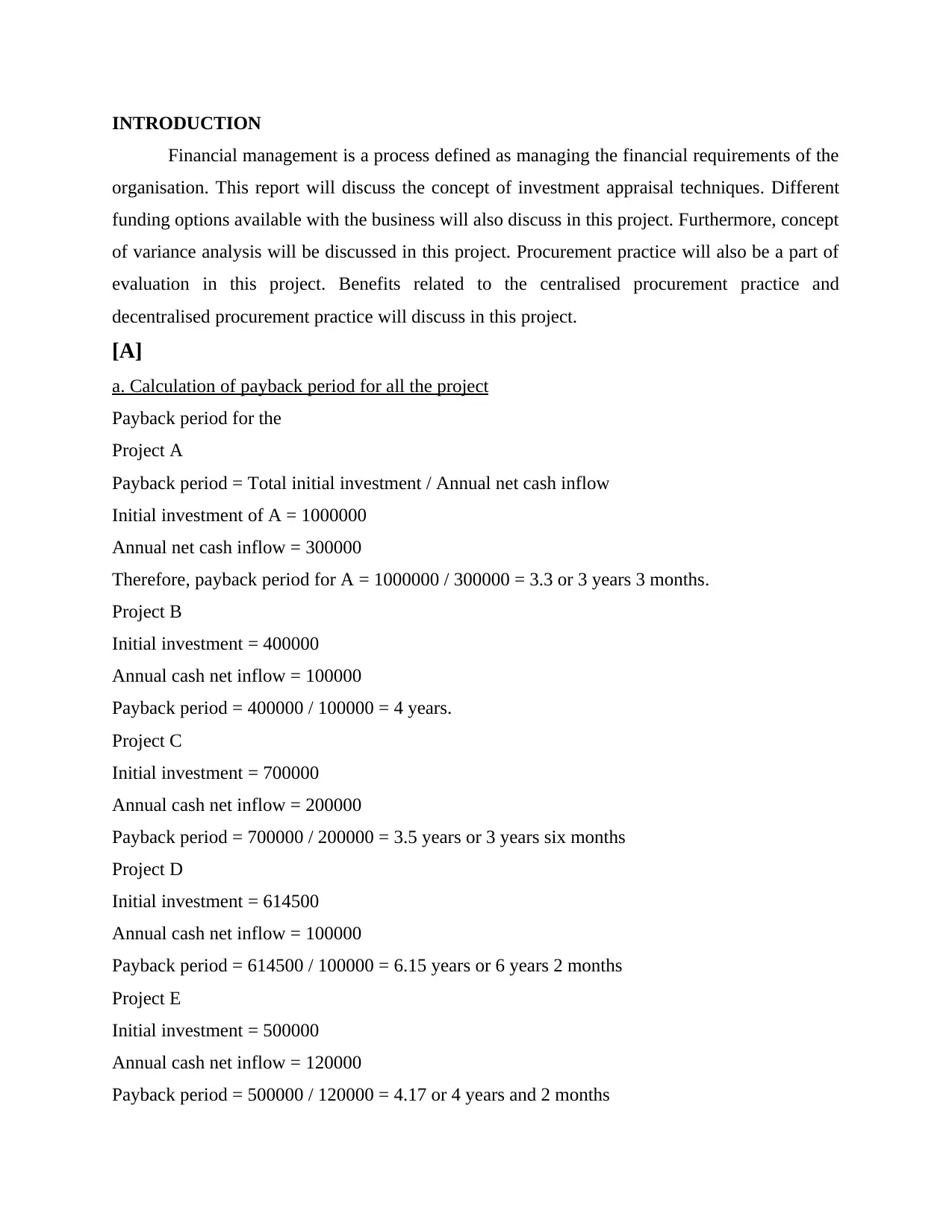
INTRODUCTION
Financial management is a process defined as managing the financial requirements of the
organisation. This report will discuss the concept of investment appraisal techniques. Different
funding options available with the business will also discuss in this project. Furthermore, concept
of variance analysis will be discussed in this project. Procurement practice will also be a part of
evaluation in this project. Benefits related to the centralised procurement practice and
decentralised procurement practice will discuss in this project.
[A]
a. Calculation of payback period for all the project
Payback period for the
Project A
Payback period = Total initial investment / Annual net cash inflow
Initial investment of A = 1000000
Annual net cash inflow = 300000
Therefore, payback period for A = 1000000 / 300000 = 3.3 or 3 years 3 months.
Project B
Initial investment = 400000
Annual cash net inflow = 100000
Payback period = 400000 / 100000 = 4 years.
Project C
Initial investment = 700000
Annual cash net inflow = 200000
Payback period = 700000 / 200000 = 3.5 years or 3 years six months
Project D
Initial investment = 614500
Annual cash net inflow = 100000
Payback period = 614500 / 100000 = 6.15 years or 6 years 2 months
Project E
Initial investment = 500000
Annual cash net inflow = 120000
Payback period = 500000 / 120000 = 4.17 or 4 years and 2 months
Financial management is a process defined as managing the financial requirements of the
organisation. This report will discuss the concept of investment appraisal techniques. Different
funding options available with the business will also discuss in this project. Furthermore, concept
of variance analysis will be discussed in this project. Procurement practice will also be a part of
evaluation in this project. Benefits related to the centralised procurement practice and
decentralised procurement practice will discuss in this project.
[A]
a. Calculation of payback period for all the project
Payback period for the
Project A
Payback period = Total initial investment / Annual net cash inflow
Initial investment of A = 1000000
Annual net cash inflow = 300000
Therefore, payback period for A = 1000000 / 300000 = 3.3 or 3 years 3 months.
Project B
Initial investment = 400000
Annual cash net inflow = 100000
Payback period = 400000 / 100000 = 4 years.
Project C
Initial investment = 700000
Annual cash net inflow = 200000
Payback period = 700000 / 200000 = 3.5 years or 3 years six months
Project D
Initial investment = 614500
Annual cash net inflow = 100000
Payback period = 614500 / 100000 = 6.15 years or 6 years 2 months
Project E
Initial investment = 500000
Annual cash net inflow = 120000
Payback period = 500000 / 120000 = 4.17 or 4 years and 2 months
⊘ This is a preview!⊘
Do you want full access?
Subscribe today to unlock all pages.

Trusted by 1+ million students worldwide

Project F
Initial investment = 560000
Annual cash net inflow = 100000
Payback period = 560000 / 100000 = 5.6 or 5 years and 7 months.
Project G
Years Cash flows Cumulative cash flow
0 -200000 -200000
1 100000 -100000
2 100000 0
3 80000 80000
4 80000 160000
5 80000 240000
6 80000 320000
From the above table it can be determined that in the second year, the cumulative cash flow is
equivalent to 0 and before and after that it was negative and positive respectively. Therefore, it
can be interpreted from it, that the payback period for this project is 2 years.
b. Calculation of Net present value for all the projects
Project
A
Project
B
Project
C
Project
D
Project
E
Project
F
Project
G
Initial investment 1000000 400000 700000 614500 500000 560000 200000
Project cash
inflows
year 1 300000 100000 200000 100000 120000 100000 100000
2 300000 100000 200000 100000 120000 100000 100000
3 300000 100000 200000 100000 120000 100000 80000
4 300000 100000 200000 100000 120000 100000 80000
5 300000 200000 100000 120000 100000 80000
6 300000 100000 120000 100000 80000
7 100000 120000 100000
8 100000 100000
9 100000 100000
10 100000 100000
Computation of NPV
PV factor Project
A
Project
B
Project
C
Project
D
Project
E
Project
F
Project
G
Initial investment = 560000
Annual cash net inflow = 100000
Payback period = 560000 / 100000 = 5.6 or 5 years and 7 months.
Project G
Years Cash flows Cumulative cash flow
0 -200000 -200000
1 100000 -100000
2 100000 0
3 80000 80000
4 80000 160000
5 80000 240000
6 80000 320000
From the above table it can be determined that in the second year, the cumulative cash flow is
equivalent to 0 and before and after that it was negative and positive respectively. Therefore, it
can be interpreted from it, that the payback period for this project is 2 years.
b. Calculation of Net present value for all the projects
Project
A
Project
B
Project
C
Project
D
Project
E
Project
F
Project
G
Initial investment 1000000 400000 700000 614500 500000 560000 200000
Project cash
inflows
year 1 300000 100000 200000 100000 120000 100000 100000
2 300000 100000 200000 100000 120000 100000 100000
3 300000 100000 200000 100000 120000 100000 80000
4 300000 100000 200000 100000 120000 100000 80000
5 300000 200000 100000 120000 100000 80000
6 300000 100000 120000 100000 80000
7 100000 120000 100000
8 100000 100000
9 100000 100000
10 100000 100000
Computation of NPV
PV factor Project
A
Project
B
Project
C
Project
D
Project
E
Project
F
Project
G
Paraphrase This Document
Need a fresh take? Get an instant paraphrase of this document with our AI Paraphraser
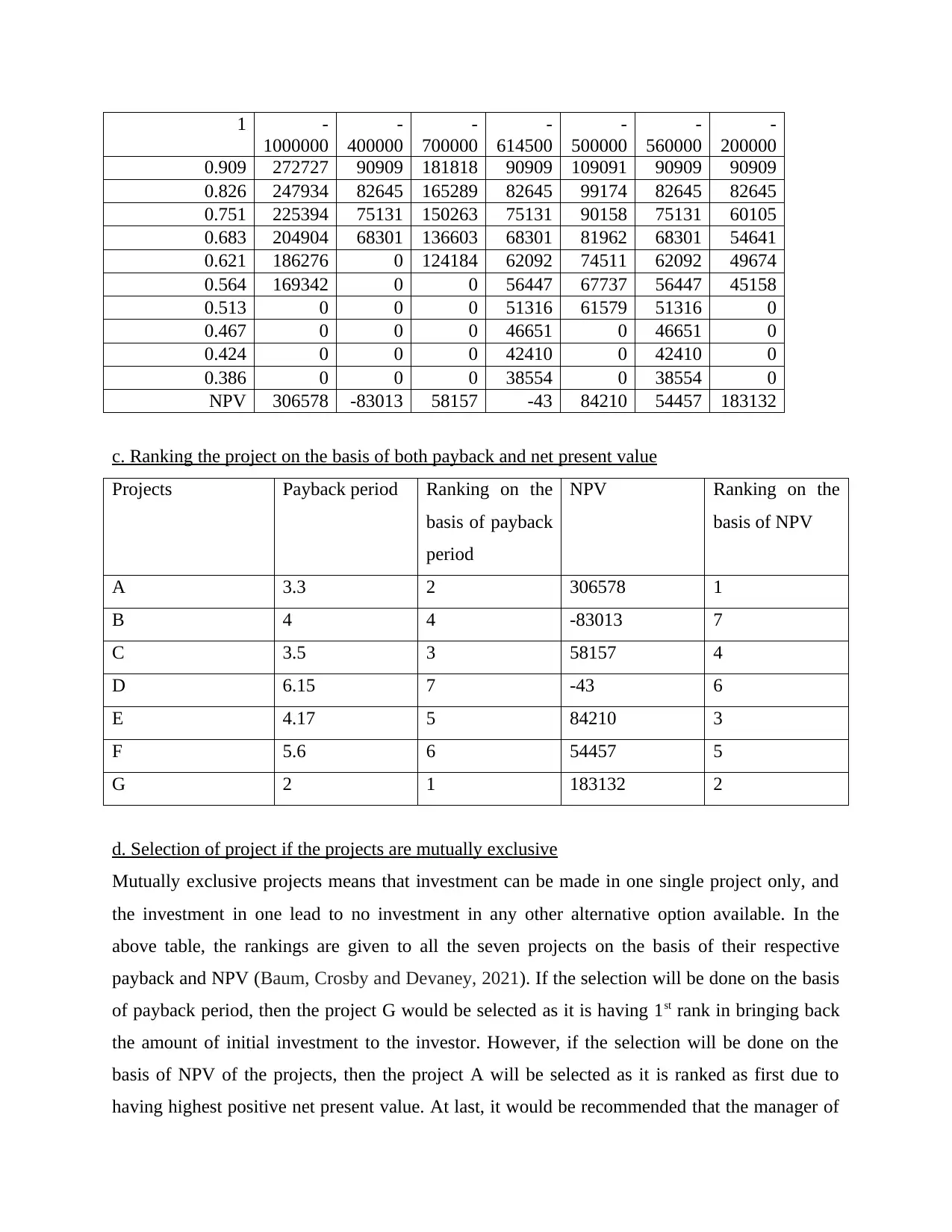
1 -
1000000
-
400000
-
700000
-
614500
-
500000
-
560000
-
200000
0.909 272727 90909 181818 90909 109091 90909 90909
0.826 247934 82645 165289 82645 99174 82645 82645
0.751 225394 75131 150263 75131 90158 75131 60105
0.683 204904 68301 136603 68301 81962 68301 54641
0.621 186276 0 124184 62092 74511 62092 49674
0.564 169342 0 0 56447 67737 56447 45158
0.513 0 0 0 51316 61579 51316 0
0.467 0 0 0 46651 0 46651 0
0.424 0 0 0 42410 0 42410 0
0.386 0 0 0 38554 0 38554 0
NPV 306578 -83013 58157 -43 84210 54457 183132
c. Ranking the project on the basis of both payback and net present value
Projects Payback period Ranking on the
basis of payback
period
NPV Ranking on the
basis of NPV
A 3.3 2 306578 1
B 4 4 -83013 7
C 3.5 3 58157 4
D 6.15 7 -43 6
E 4.17 5 84210 3
F 5.6 6 54457 5
G 2 1 183132 2
d. Selection of project if the projects are mutually exclusive
Mutually exclusive projects means that investment can be made in one single project only, and
the investment in one lead to no investment in any other alternative option available. In the
above table, the rankings are given to all the seven projects on the basis of their respective
payback and NPV (Baum, Crosby and Devaney, 2021). If the selection will be done on the basis
of payback period, then the project G would be selected as it is having 1st rank in bringing back
the amount of initial investment to the investor. However, if the selection will be done on the
basis of NPV of the projects, then the project A will be selected as it is ranked as first due to
having highest positive net present value. At last, it would be recommended that the manager of
1000000
-
400000
-
700000
-
614500
-
500000
-
560000
-
200000
0.909 272727 90909 181818 90909 109091 90909 90909
0.826 247934 82645 165289 82645 99174 82645 82645
0.751 225394 75131 150263 75131 90158 75131 60105
0.683 204904 68301 136603 68301 81962 68301 54641
0.621 186276 0 124184 62092 74511 62092 49674
0.564 169342 0 0 56447 67737 56447 45158
0.513 0 0 0 51316 61579 51316 0
0.467 0 0 0 46651 0 46651 0
0.424 0 0 0 42410 0 42410 0
0.386 0 0 0 38554 0 38554 0
NPV 306578 -83013 58157 -43 84210 54457 183132
c. Ranking the project on the basis of both payback and net present value
Projects Payback period Ranking on the
basis of payback
period
NPV Ranking on the
basis of NPV
A 3.3 2 306578 1
B 4 4 -83013 7
C 3.5 3 58157 4
D 6.15 7 -43 6
E 4.17 5 84210 3
F 5.6 6 54457 5
G 2 1 183132 2
d. Selection of project if the projects are mutually exclusive
Mutually exclusive projects means that investment can be made in one single project only, and
the investment in one lead to no investment in any other alternative option available. In the
above table, the rankings are given to all the seven projects on the basis of their respective
payback and NPV (Baum, Crosby and Devaney, 2021). If the selection will be done on the basis
of payback period, then the project G would be selected as it is having 1st rank in bringing back
the amount of initial investment to the investor. However, if the selection will be done on the
basis of NPV of the projects, then the project A will be selected as it is ranked as first due to
having highest positive net present value. At last, it would be recommended that the manager of
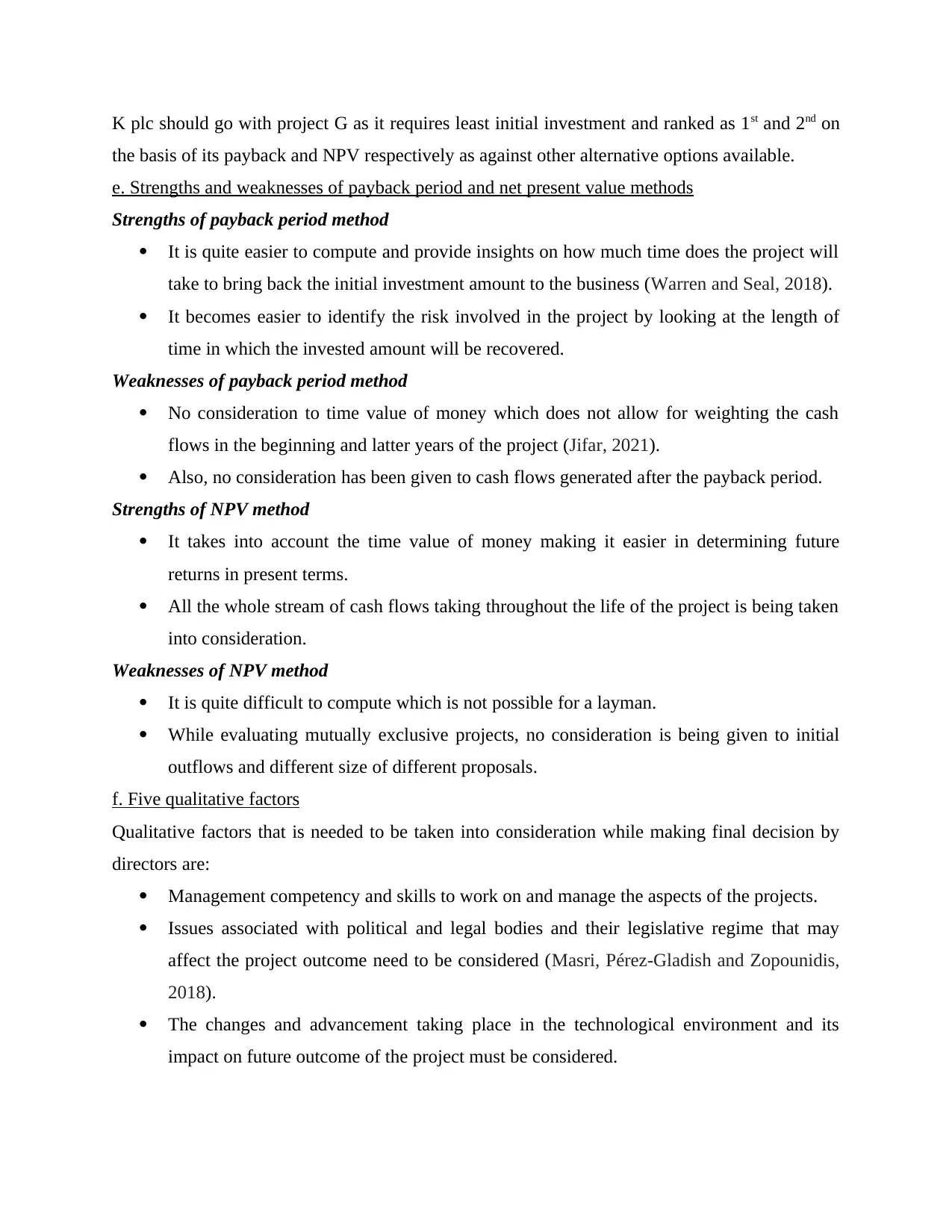
K plc should go with project G as it requires least initial investment and ranked as 1st and 2nd on
the basis of its payback and NPV respectively as against other alternative options available.
e. Strengths and weaknesses of payback period and net present value methods
Strengths of payback period method
It is quite easier to compute and provide insights on how much time does the project will
take to bring back the initial investment amount to the business (Warren and Seal, 2018).
It becomes easier to identify the risk involved in the project by looking at the length of
time in which the invested amount will be recovered.
Weaknesses of payback period method
No consideration to time value of money which does not allow for weighting the cash
flows in the beginning and latter years of the project (Jifar, 2021).
Also, no consideration has been given to cash flows generated after the payback period.
Strengths of NPV method
It takes into account the time value of money making it easier in determining future
returns in present terms.
All the whole stream of cash flows taking throughout the life of the project is being taken
into consideration.
Weaknesses of NPV method
It is quite difficult to compute which is not possible for a layman.
While evaluating mutually exclusive projects, no consideration is being given to initial
outflows and different size of different proposals.
f. Five qualitative factors
Qualitative factors that is needed to be taken into consideration while making final decision by
directors are:
Management competency and skills to work on and manage the aspects of the projects.
Issues associated with political and legal bodies and their legislative regime that may
affect the project outcome need to be considered (Masri, Pérez-Gladish and Zopounidis,
2018).
The changes and advancement taking place in the technological environment and its
impact on future outcome of the project must be considered.
the basis of its payback and NPV respectively as against other alternative options available.
e. Strengths and weaknesses of payback period and net present value methods
Strengths of payback period method
It is quite easier to compute and provide insights on how much time does the project will
take to bring back the initial investment amount to the business (Warren and Seal, 2018).
It becomes easier to identify the risk involved in the project by looking at the length of
time in which the invested amount will be recovered.
Weaknesses of payback period method
No consideration to time value of money which does not allow for weighting the cash
flows in the beginning and latter years of the project (Jifar, 2021).
Also, no consideration has been given to cash flows generated after the payback period.
Strengths of NPV method
It takes into account the time value of money making it easier in determining future
returns in present terms.
All the whole stream of cash flows taking throughout the life of the project is being taken
into consideration.
Weaknesses of NPV method
It is quite difficult to compute which is not possible for a layman.
While evaluating mutually exclusive projects, no consideration is being given to initial
outflows and different size of different proposals.
f. Five qualitative factors
Qualitative factors that is needed to be taken into consideration while making final decision by
directors are:
Management competency and skills to work on and manage the aspects of the projects.
Issues associated with political and legal bodies and their legislative regime that may
affect the project outcome need to be considered (Masri, Pérez-Gladish and Zopounidis,
2018).
The changes and advancement taking place in the technological environment and its
impact on future outcome of the project must be considered.
⊘ This is a preview!⊘
Do you want full access?
Subscribe today to unlock all pages.

Trusted by 1+ million students worldwide
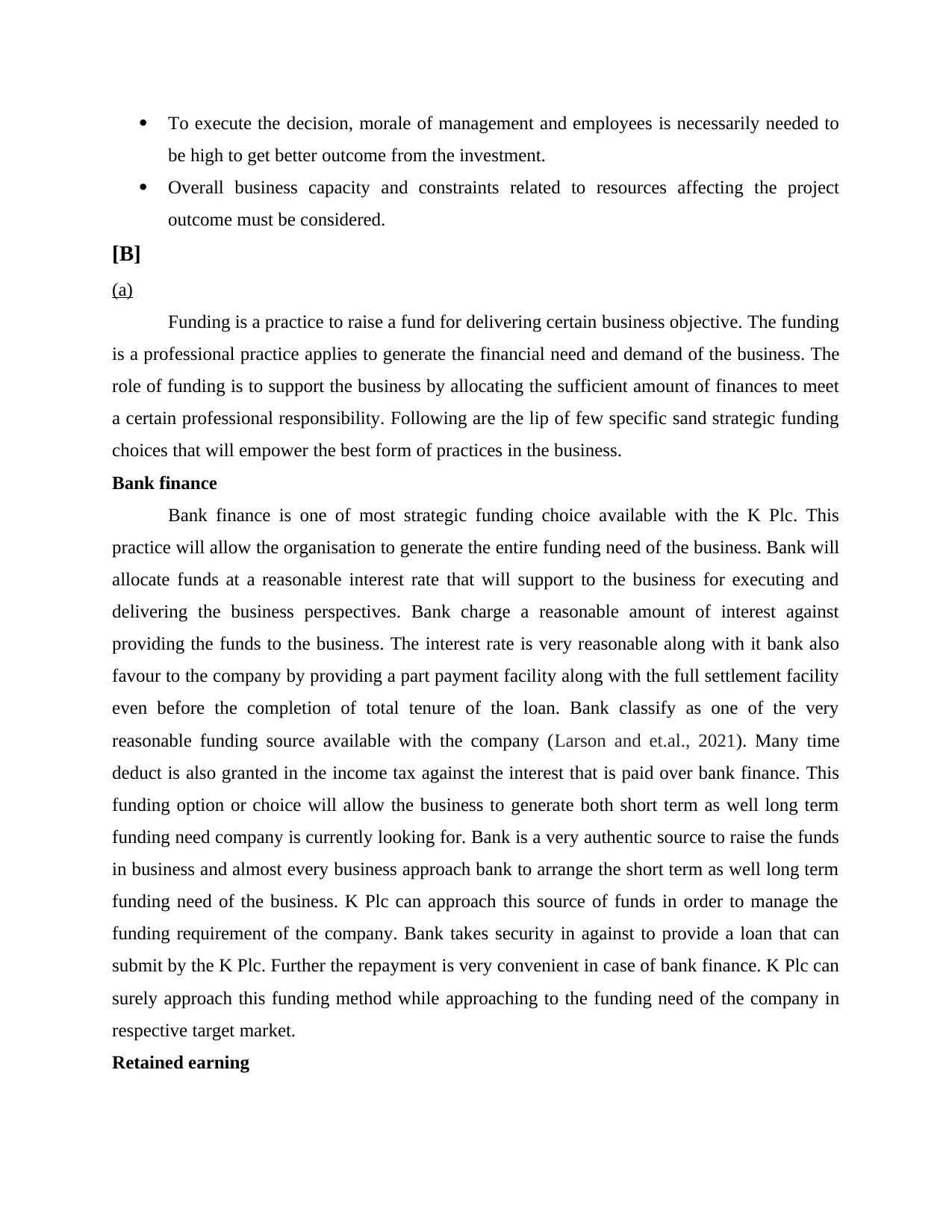
To execute the decision, morale of management and employees is necessarily needed to
be high to get better outcome from the investment.
Overall business capacity and constraints related to resources affecting the project
outcome must be considered.
[B]
(a)
Funding is a practice to raise a fund for delivering certain business objective. The funding
is a professional practice applies to generate the financial need and demand of the business. The
role of funding is to support the business by allocating the sufficient amount of finances to meet
a certain professional responsibility. Following are the lip of few specific sand strategic funding
choices that will empower the best form of practices in the business.
Bank finance
Bank finance is one of most strategic funding choice available with the K Plc. This
practice will allow the organisation to generate the entire funding need of the business. Bank will
allocate funds at a reasonable interest rate that will support to the business for executing and
delivering the business perspectives. Bank charge a reasonable amount of interest against
providing the funds to the business. The interest rate is very reasonable along with it bank also
favour to the company by providing a part payment facility along with the full settlement facility
even before the completion of total tenure of the loan. Bank classify as one of the very
reasonable funding source available with the company (Larson and et.al., 2021). Many time
deduct is also granted in the income tax against the interest that is paid over bank finance. This
funding option or choice will allow the business to generate both short term as well long term
funding need company is currently looking for. Bank is a very authentic source to raise the funds
in business and almost every business approach bank to arrange the short term as well long term
funding need of the business. K Plc can approach this source of funds in order to manage the
funding requirement of the company. Bank takes security in against to provide a loan that can
submit by the K Plc. Further the repayment is very convenient in case of bank finance. K Plc can
surely approach this funding method while approaching to the funding need of the company in
respective target market.
Retained earning
be high to get better outcome from the investment.
Overall business capacity and constraints related to resources affecting the project
outcome must be considered.
[B]
(a)
Funding is a practice to raise a fund for delivering certain business objective. The funding
is a professional practice applies to generate the financial need and demand of the business. The
role of funding is to support the business by allocating the sufficient amount of finances to meet
a certain professional responsibility. Following are the lip of few specific sand strategic funding
choices that will empower the best form of practices in the business.
Bank finance
Bank finance is one of most strategic funding choice available with the K Plc. This
practice will allow the organisation to generate the entire funding need of the business. Bank will
allocate funds at a reasonable interest rate that will support to the business for executing and
delivering the business perspectives. Bank charge a reasonable amount of interest against
providing the funds to the business. The interest rate is very reasonable along with it bank also
favour to the company by providing a part payment facility along with the full settlement facility
even before the completion of total tenure of the loan. Bank classify as one of the very
reasonable funding source available with the company (Larson and et.al., 2021). Many time
deduct is also granted in the income tax against the interest that is paid over bank finance. This
funding option or choice will allow the business to generate both short term as well long term
funding need company is currently looking for. Bank is a very authentic source to raise the funds
in business and almost every business approach bank to arrange the short term as well long term
funding need of the business. K Plc can approach this source of funds in order to manage the
funding requirement of the company. Bank takes security in against to provide a loan that can
submit by the K Plc. Further the repayment is very convenient in case of bank finance. K Plc can
surely approach this funding method while approaching to the funding need of the company in
respective target market.
Retained earning
Paraphrase This Document
Need a fresh take? Get an instant paraphrase of this document with our AI Paraphraser
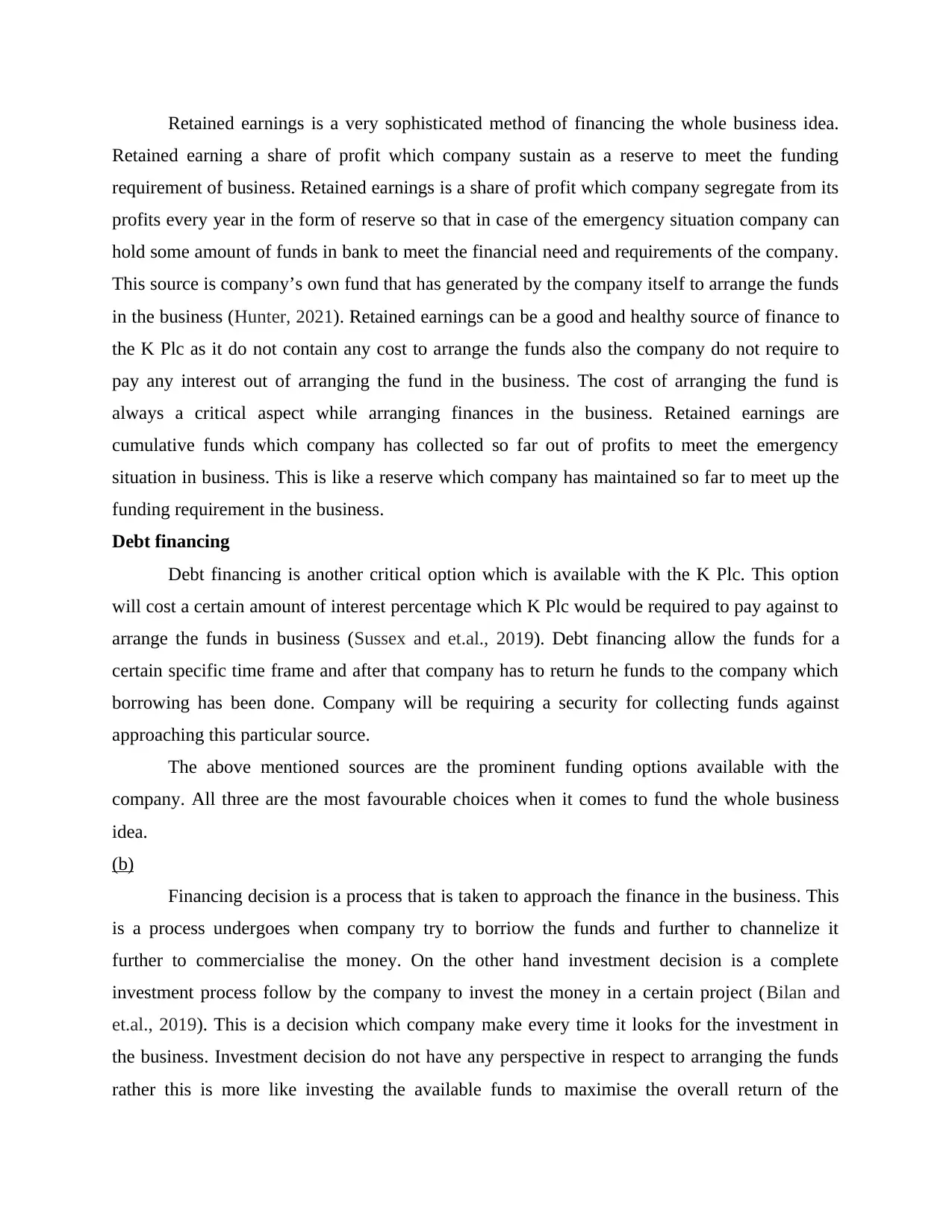
Retained earnings is a very sophisticated method of financing the whole business idea.
Retained earning a share of profit which company sustain as a reserve to meet the funding
requirement of business. Retained earnings is a share of profit which company segregate from its
profits every year in the form of reserve so that in case of the emergency situation company can
hold some amount of funds in bank to meet the financial need and requirements of the company.
This source is company’s own fund that has generated by the company itself to arrange the funds
in the business (Hunter, 2021). Retained earnings can be a good and healthy source of finance to
the K Plc as it do not contain any cost to arrange the funds also the company do not require to
pay any interest out of arranging the fund in the business. The cost of arranging the fund is
always a critical aspect while arranging finances in the business. Retained earnings are
cumulative funds which company has collected so far out of profits to meet the emergency
situation in business. This is like a reserve which company has maintained so far to meet up the
funding requirement in the business.
Debt financing
Debt financing is another critical option which is available with the K Plc. This option
will cost a certain amount of interest percentage which K Plc would be required to pay against to
arrange the funds in business (Sussex and et.al., 2019). Debt financing allow the funds for a
certain specific time frame and after that company has to return he funds to the company which
borrowing has been done. Company will be requiring a security for collecting funds against
approaching this particular source.
The above mentioned sources are the prominent funding options available with the
company. All three are the most favourable choices when it comes to fund the whole business
idea.
(b)
Financing decision is a process that is taken to approach the finance in the business. This
is a process undergoes when company try to borriow the funds and further to channelize it
further to commercialise the money. On the other hand investment decision is a complete
investment process follow by the company to invest the money in a certain project (Bilan and
et.al., 2019). This is a decision which company make every time it looks for the investment in
the business. Investment decision do not have any perspective in respect to arranging the funds
rather this is more like investing the available funds to maximise the overall return of the
Retained earning a share of profit which company sustain as a reserve to meet the funding
requirement of business. Retained earnings is a share of profit which company segregate from its
profits every year in the form of reserve so that in case of the emergency situation company can
hold some amount of funds in bank to meet the financial need and requirements of the company.
This source is company’s own fund that has generated by the company itself to arrange the funds
in the business (Hunter, 2021). Retained earnings can be a good and healthy source of finance to
the K Plc as it do not contain any cost to arrange the funds also the company do not require to
pay any interest out of arranging the fund in the business. The cost of arranging the fund is
always a critical aspect while arranging finances in the business. Retained earnings are
cumulative funds which company has collected so far out of profits to meet the emergency
situation in business. This is like a reserve which company has maintained so far to meet up the
funding requirement in the business.
Debt financing
Debt financing is another critical option which is available with the K Plc. This option
will cost a certain amount of interest percentage which K Plc would be required to pay against to
arrange the funds in business (Sussex and et.al., 2019). Debt financing allow the funds for a
certain specific time frame and after that company has to return he funds to the company which
borrowing has been done. Company will be requiring a security for collecting funds against
approaching this particular source.
The above mentioned sources are the prominent funding options available with the
company. All three are the most favourable choices when it comes to fund the whole business
idea.
(b)
Financing decision is a process that is taken to approach the finance in the business. This
is a process undergoes when company try to borriow the funds and further to channelize it
further to commercialise the money. On the other hand investment decision is a complete
investment process follow by the company to invest the money in a certain project (Bilan and
et.al., 2019). This is a decision which company make every time it looks for the investment in
the business. Investment decision do not have any perspective in respect to arranging the funds
rather this is more like investing the available funds to maximise the overall return of the

business (Palepu and et.al., 2020). Financing is a practice follow to collect and arrange the funds
and investment decision on the other part is about to utilise the available funds in such manner
that company can get some healthy rerun in business. Investing come after the funds are arranged
in business. Both the processes are different from each other.
[C]
(a) Preparation of full variance analysis statement for K Plc manufacturer
Variable cost
element
Standard cost for
Actual output (9000
units) £
Actual Cost for actual
output (9000 units)
£
Variance (Standard
cost - Actual cost)
Direct Material S
27000
(9000 kg * 3)
29750
(8500 kg * 3.5)
-2750
Direct Material T
18000
(18000 kg * 3)
18000
(18000 kg * 1)
0
Direct Labor
270000
(27000 hours * 10)
294000
(28000 hours * 5.89)
-24000
Variable
overheads
162000
(27000 hours * 6)
165000 -3000
Total variable
production cost 477000 506750 -29750
(b) Explanation of Variance Identified
On the basis of above calculation of variance analysis, it is identified that the efficiency of K
plc is poor. It is because the total actual variable production cost of company is higher than the
standard variable production cost. The actual direct material S cost, actual labour cost and actual
variable overhead cost of K plc is higher than the standard cost. Only direct material T cost is
good because the actual and standard cost are equal with zero variance. Beside this, in all the
other variable cost of production is unfavourable variance is found. This might be because of the
improper management of production, higher wastage of resources, laziness of employees etc.
Thus, the company have to improve all these areas in order to manage the higher production
within the business and low cost of production. For this, it is advisable to K plc that they should
and investment decision on the other part is about to utilise the available funds in such manner
that company can get some healthy rerun in business. Investing come after the funds are arranged
in business. Both the processes are different from each other.
[C]
(a) Preparation of full variance analysis statement for K Plc manufacturer
Variable cost
element
Standard cost for
Actual output (9000
units) £
Actual Cost for actual
output (9000 units)
£
Variance (Standard
cost - Actual cost)
Direct Material S
27000
(9000 kg * 3)
29750
(8500 kg * 3.5)
-2750
Direct Material T
18000
(18000 kg * 3)
18000
(18000 kg * 1)
0
Direct Labor
270000
(27000 hours * 10)
294000
(28000 hours * 5.89)
-24000
Variable
overheads
162000
(27000 hours * 6)
165000 -3000
Total variable
production cost 477000 506750 -29750
(b) Explanation of Variance Identified
On the basis of above calculation of variance analysis, it is identified that the efficiency of K
plc is poor. It is because the total actual variable production cost of company is higher than the
standard variable production cost. The actual direct material S cost, actual labour cost and actual
variable overhead cost of K plc is higher than the standard cost. Only direct material T cost is
good because the actual and standard cost are equal with zero variance. Beside this, in all the
other variable cost of production is unfavourable variance is found. This might be because of the
improper management of production, higher wastage of resources, laziness of employees etc.
Thus, the company have to improve all these areas in order to manage the higher production
within the business and low cost of production. For this, it is advisable to K plc that they should
⊘ This is a preview!⊘
Do you want full access?
Subscribe today to unlock all pages.

Trusted by 1+ million students worldwide
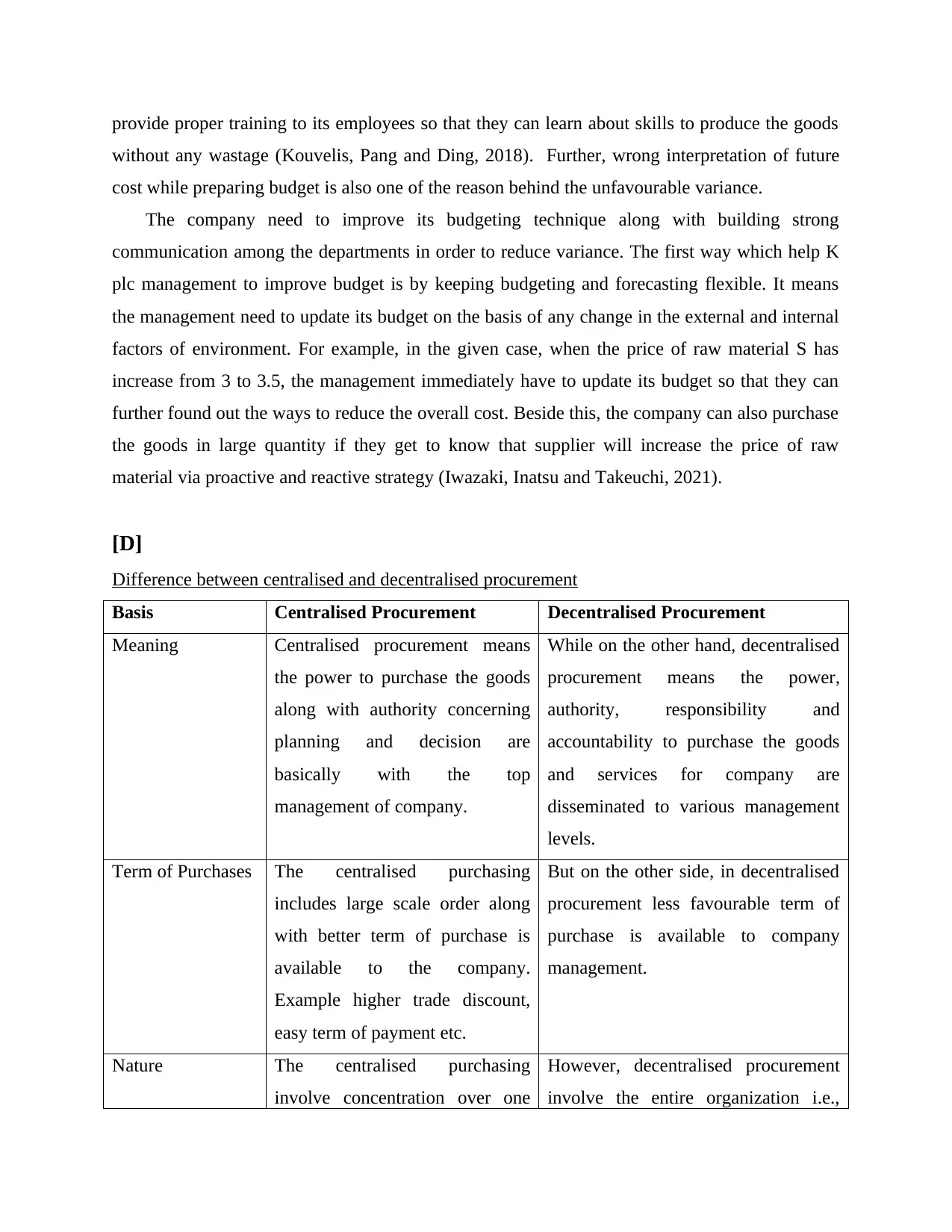
provide proper training to its employees so that they can learn about skills to produce the goods
without any wastage (Kouvelis, Pang and Ding, 2018). Further, wrong interpretation of future
cost while preparing budget is also one of the reason behind the unfavourable variance.
The company need to improve its budgeting technique along with building strong
communication among the departments in order to reduce variance. The first way which help K
plc management to improve budget is by keeping budgeting and forecasting flexible. It means
the management need to update its budget on the basis of any change in the external and internal
factors of environment. For example, in the given case, when the price of raw material S has
increase from 3 to 3.5, the management immediately have to update its budget so that they can
further found out the ways to reduce the overall cost. Beside this, the company can also purchase
the goods in large quantity if they get to know that supplier will increase the price of raw
material via proactive and reactive strategy (Iwazaki, Inatsu and Takeuchi, 2021).
[D]
Difference between centralised and decentralised procurement
Basis Centralised Procurement Decentralised Procurement
Meaning Centralised procurement means
the power to purchase the goods
along with authority concerning
planning and decision are
basically with the top
management of company.
While on the other hand, decentralised
procurement means the power,
authority, responsibility and
accountability to purchase the goods
and services for company are
disseminated to various management
levels.
Term of Purchases The centralised purchasing
includes large scale order along
with better term of purchase is
available to the company.
Example higher trade discount,
easy term of payment etc.
But on the other side, in decentralised
procurement less favourable term of
purchase is available to company
management.
Nature The centralised purchasing
involve concentration over one
However, decentralised procurement
involve the entire organization i.e.,
without any wastage (Kouvelis, Pang and Ding, 2018). Further, wrong interpretation of future
cost while preparing budget is also one of the reason behind the unfavourable variance.
The company need to improve its budgeting technique along with building strong
communication among the departments in order to reduce variance. The first way which help K
plc management to improve budget is by keeping budgeting and forecasting flexible. It means
the management need to update its budget on the basis of any change in the external and internal
factors of environment. For example, in the given case, when the price of raw material S has
increase from 3 to 3.5, the management immediately have to update its budget so that they can
further found out the ways to reduce the overall cost. Beside this, the company can also purchase
the goods in large quantity if they get to know that supplier will increase the price of raw
material via proactive and reactive strategy (Iwazaki, Inatsu and Takeuchi, 2021).
[D]
Difference between centralised and decentralised procurement
Basis Centralised Procurement Decentralised Procurement
Meaning Centralised procurement means
the power to purchase the goods
along with authority concerning
planning and decision are
basically with the top
management of company.
While on the other hand, decentralised
procurement means the power,
authority, responsibility and
accountability to purchase the goods
and services for company are
disseminated to various management
levels.
Term of Purchases The centralised purchasing
includes large scale order along
with better term of purchase is
available to the company.
Example higher trade discount,
easy term of payment etc.
But on the other side, in decentralised
procurement less favourable term of
purchase is available to company
management.
Nature The centralised purchasing
involve concentration over one
However, decentralised procurement
involve the entire organization i.e.,
Paraphrase This Document
Need a fresh take? Get an instant paraphrase of this document with our AI Paraphraser

department usually via two
people subordinates and manager
(Janssen, and Stuijts, 2021).
from top management to individual
departments.
Risk of
obsolescence
In centralised procurement, the
risk of obsolescence of goods is
quite high which sometime leads
to heavy financial loss to
company
But, the same risk of obsolescence of
goods and services in the case of
decentralized purchasing is quite low
and sometime nil.
Control The control over the buying
exercise in the centralised
procurement is work effectively.
While on the other side, the effective
control over the purchasing in
decentralised procurement is not
possible.
Cost of internal
transport
The cost of internal transport in
the case of centralised
procurement is high.
The cost of internal transport in the
case of decentralised procurement is
less (Israel, Kazungu and Mchopa,
2019).
Investment For purchasing goods at large lots
and quantity, the company require
heavy finance or fund.
But, as decentralised procurement
involve only right quantity of material
thus no heavy fund is require.
Availability The chance of non-availability of
material for production is highly
possible in centralised
procurement case.
The goods are also available to
company in case of decentralised
procurement.
Benefits of centralised purchasing and decentralised purchasing
Benefits of centralised purchasing:
It is helpful for the company to purchase goods in large quantity with the help of
specialized and expert purchasing staffs. They basically concentrate over one department
only.
people subordinates and manager
(Janssen, and Stuijts, 2021).
from top management to individual
departments.
Risk of
obsolescence
In centralised procurement, the
risk of obsolescence of goods is
quite high which sometime leads
to heavy financial loss to
company
But, the same risk of obsolescence of
goods and services in the case of
decentralized purchasing is quite low
and sometime nil.
Control The control over the buying
exercise in the centralised
procurement is work effectively.
While on the other side, the effective
control over the purchasing in
decentralised procurement is not
possible.
Cost of internal
transport
The cost of internal transport in
the case of centralised
procurement is high.
The cost of internal transport in the
case of decentralised procurement is
less (Israel, Kazungu and Mchopa,
2019).
Investment For purchasing goods at large lots
and quantity, the company require
heavy finance or fund.
But, as decentralised procurement
involve only right quantity of material
thus no heavy fund is require.
Availability The chance of non-availability of
material for production is highly
possible in centralised
procurement case.
The goods are also available to
company in case of decentralised
procurement.
Benefits of centralised purchasing and decentralised purchasing
Benefits of centralised purchasing:
It is helpful for the company to purchase goods in large quantity with the help of
specialized and expert purchasing staffs. They basically concentrate over one department
only.
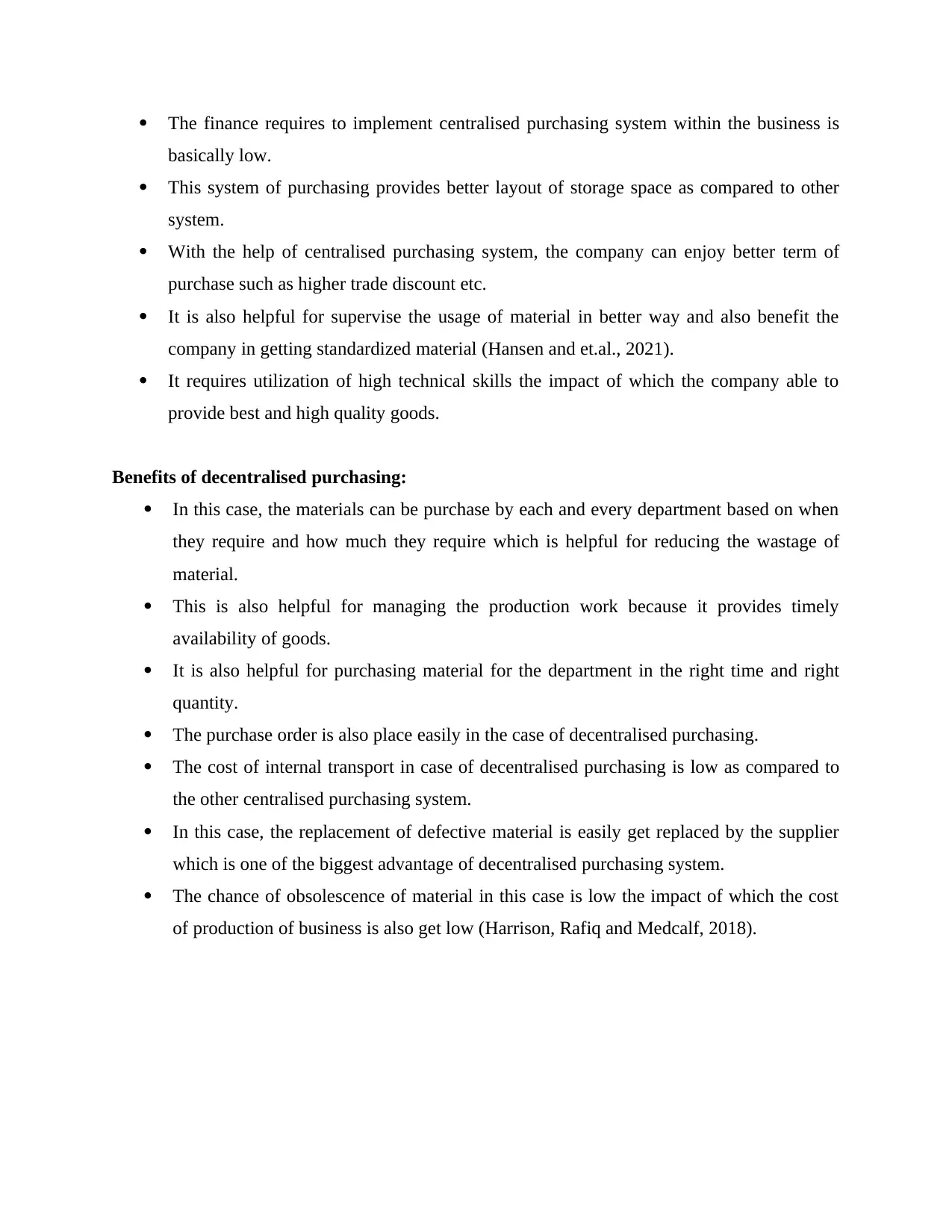
The finance requires to implement centralised purchasing system within the business is
basically low.
This system of purchasing provides better layout of storage space as compared to other
system.
With the help of centralised purchasing system, the company can enjoy better term of
purchase such as higher trade discount etc.
It is also helpful for supervise the usage of material in better way and also benefit the
company in getting standardized material (Hansen and et.al., 2021).
It requires utilization of high technical skills the impact of which the company able to
provide best and high quality goods.
Benefits of decentralised purchasing:
In this case, the materials can be purchase by each and every department based on when
they require and how much they require which is helpful for reducing the wastage of
material.
This is also helpful for managing the production work because it provides timely
availability of goods.
It is also helpful for purchasing material for the department in the right time and right
quantity.
The purchase order is also place easily in the case of decentralised purchasing.
The cost of internal transport in case of decentralised purchasing is low as compared to
the other centralised purchasing system.
In this case, the replacement of defective material is easily get replaced by the supplier
which is one of the biggest advantage of decentralised purchasing system.
The chance of obsolescence of material in this case is low the impact of which the cost
of production of business is also get low (Harrison, Rafiq and Medcalf, 2018).
basically low.
This system of purchasing provides better layout of storage space as compared to other
system.
With the help of centralised purchasing system, the company can enjoy better term of
purchase such as higher trade discount etc.
It is also helpful for supervise the usage of material in better way and also benefit the
company in getting standardized material (Hansen and et.al., 2021).
It requires utilization of high technical skills the impact of which the company able to
provide best and high quality goods.
Benefits of decentralised purchasing:
In this case, the materials can be purchase by each and every department based on when
they require and how much they require which is helpful for reducing the wastage of
material.
This is also helpful for managing the production work because it provides timely
availability of goods.
It is also helpful for purchasing material for the department in the right time and right
quantity.
The purchase order is also place easily in the case of decentralised purchasing.
The cost of internal transport in case of decentralised purchasing is low as compared to
the other centralised purchasing system.
In this case, the replacement of defective material is easily get replaced by the supplier
which is one of the biggest advantage of decentralised purchasing system.
The chance of obsolescence of material in this case is low the impact of which the cost
of production of business is also get low (Harrison, Rafiq and Medcalf, 2018).
⊘ This is a preview!⊘
Do you want full access?
Subscribe today to unlock all pages.

Trusted by 1+ million students worldwide
1 out of 15
Related Documents
Your All-in-One AI-Powered Toolkit for Academic Success.
+13062052269
info@desklib.com
Available 24*7 on WhatsApp / Email
![[object Object]](/_next/static/media/star-bottom.7253800d.svg)
Unlock your academic potential
Copyright © 2020–2026 A2Z Services. All Rights Reserved. Developed and managed by ZUCOL.





